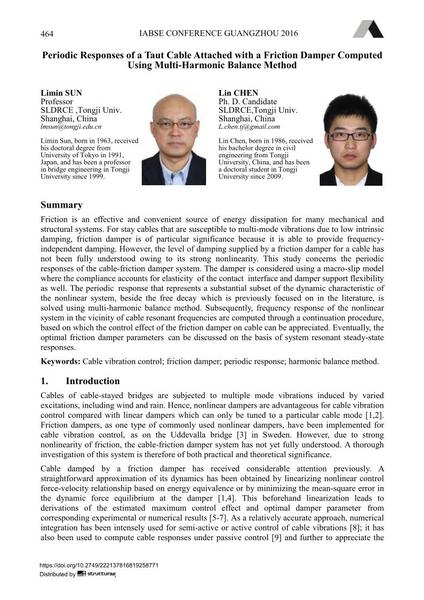Periodic Responses of a Taut Cable Attached with a Friction Damper Computed Using Multi-Harmonic Balance Method

|
|
|||||||||||
Bibliografische Angaben
| Autor(en): |
Limin Sun
Lin Chen |
||||
|---|---|---|---|---|---|
| Medium: | Tagungsbeitrag | ||||
| Sprache(n): | Englisch | ||||
| Tagung: | IABSE Conference: Bridges and Structures Sustainability - Seeking Intelligent Solutions, Guangzhou, China, 8-11 May 2016 | ||||
| Veröffentlicht in: | IABSE Conference, Guangzhou, China, 8 – 11 May 2016 | ||||
|
|||||
| Seite(n): | 464-471 | ||||
| Anzahl der Seiten (im PDF): | 8 | ||||
| Jahr: | 2016 | ||||
| DOI: | 10.2749/222137816819258771 | ||||
| Abstrakt: |
Friction is an effective and convenient source of energy dissipation for many mechanical and structural systems. For stay cables that are susceptible to multi-mode vibrations due to low intrinsic damping, friction damper is of particular significance because it is able to provide frequency- independent damping. However, the level of damping supplied by a friction damper for a cable has not been fully understood owing to its strong nonlinearity. This study concerns the periodic responses of the cable-friction damper system. The damper is considered using a macro-slip model where the compliance accounts for elasticity of the contact interface and damper support flexibility as well. The periodic response that represents a substantial subset of the dynamic characteristic of the nonlinear system, beside the free decay which is previously focused on in the literature, is solved using multi-harmonic balance method. Subsequently, frequency response of the nonlinear system in the vicinity of cable resonant frequencies are computed through a continuation procedure, based on which the control effect of the friction damper on cable can be appreciated. Eventually, the optimal friction damper parameters can be discussed on the basis of system resonant steady-state responses. |
||||
